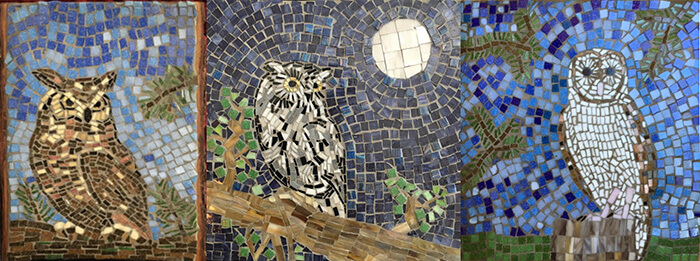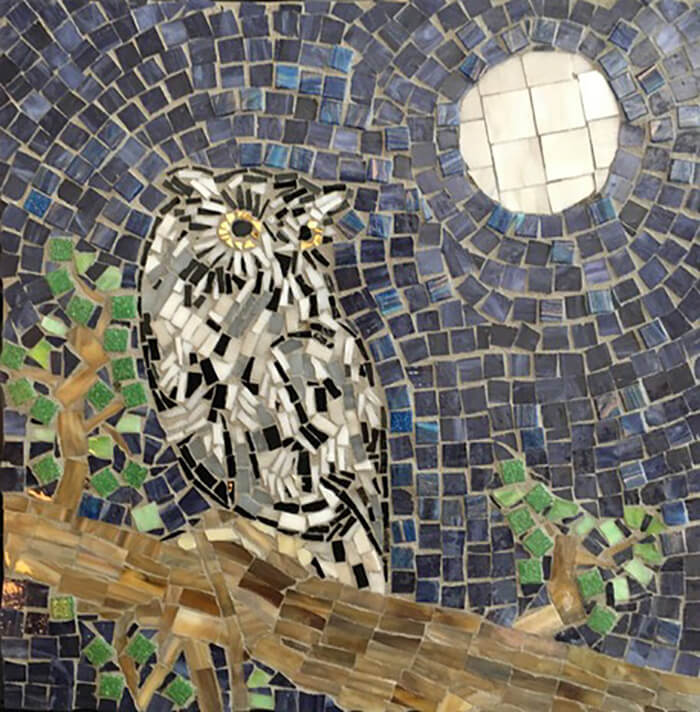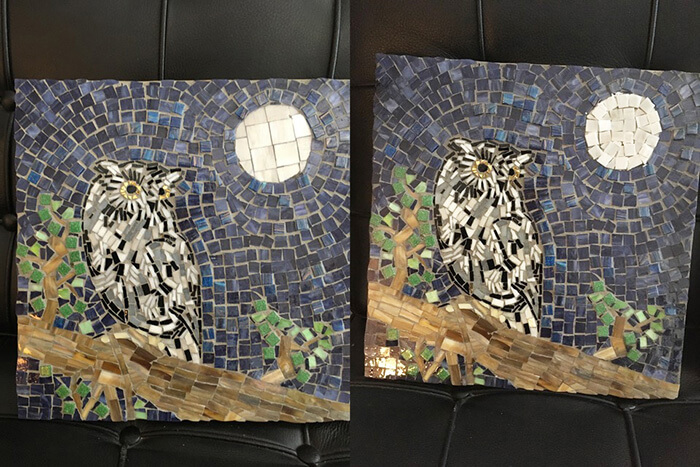Linda Lawton emailed me some pics of her recent owl mosaics, and one of them had an issue that made it a good teaching example about the importance of andamento. That mosaic also became a case study for how to mosaic on top of part of an existing mosaic if you want to rework a detail.

Since Linda is serious about her art and is always working to improve it, I felt like I could be honest with her in a way I couldn’t when critiquing the artwork of “someone I didn’t know.”
Over the past few years, Linda had emailed me about several different mosaics where she had ripped up tiles and re-executed details she wasn’t happy with. Some people have the true artist’s obsession with art and making it better, and it shows no matter the age or skill level.
I also watched Linda go from figuring out the basics of composition to making these owls, which I think are quite good. I know I would be pleased to have made any one of them, much less the series. Except for that moon. It plagued me.
Clarification of Terms
I often say andamento when I mean opus musivum, which is the style of mosaic where background tiles are arranged in concentric rows around the figures like ripples on a puddle.
If andamento is defined as creating visual flow and motion in a mosaic by arranging tiles in rows, then I say that only the opus musivum style really does that. Random angular shards (opus paladanium) and square grids (opus regulatum) do not lead the eye around the composition.
In my opinion, backgrounds made from square grids are wasted opportunities to create additional visual interest, and using a square grid arrangement for a figure in the foreground just plane looks out of place, especially if the other figures use curving arrangements of tile.
That brings me to the problem in one of Linda’s owl mosaics.
Eastern Screech Owl Mosaic

Notice how lovingly the owl itself is rendered with narrow pieces of tile that show the flow and texture of the plumage. Notice how the background seems to cradle and envelope the moon and the owl because the background tiles are arranged in concentric rows around them.
Now look at the rectilinear grid used for the moon. Notice how flat it looks compared to the sky just around it. A sphere should certainly have contours if every other shape in the mosaic has contours. My initial impression was that the moon looked like a hole in the mosaic that had been bricked up.
The details you always notice the most after you finish a mosaic are the ones you didn’t think about or rushed through just to complete the mosaic.

Of course that wasn’t my initial response to Linda. I was too blown away by how much progress she had made and how jealous I was of the series.
But I kept thinking about that moon. Finally when Linda emailed me back, I proposed doing something about the moon in a novel way: tile a new version of the moon on top of the existing tile.
They really look great, but I do keep thinking about one detail I would change. (I do that with my own art too.) The moon is tiled in a grid, but everything else is concentric flowing andamento.
I’ve thought about retiling certain parts of my mosaics by tiling on top of the existing tile and just having it stick out slightly. I’ve even thought about doing this with external work because the thinset would stick to the faces of the tiles.
I thought Linda would email me her thoughts on the idea, but once she arranged some tiles on the moon as a study, she liked the improvement and just went with it.
A layer of glass tile is only about 1/8 inch high, and so it doesn’t really stick out enough to make a difference visually.
Safety Concerns
Mosaic elements that extend above the rest of the surface are not suitable in floor mosaics due to the trip hazard they represent and their potential to be damaged by foot traffic.
Raised mosaic elements could be a problem on other architectural surfaces if the edges of the raised elements become jagged due to incidental damage.
For a mosaic plaque or art object, those things aren’t a critical safety issue because the art is moveable and not cemented into the building.


Leave a Reply